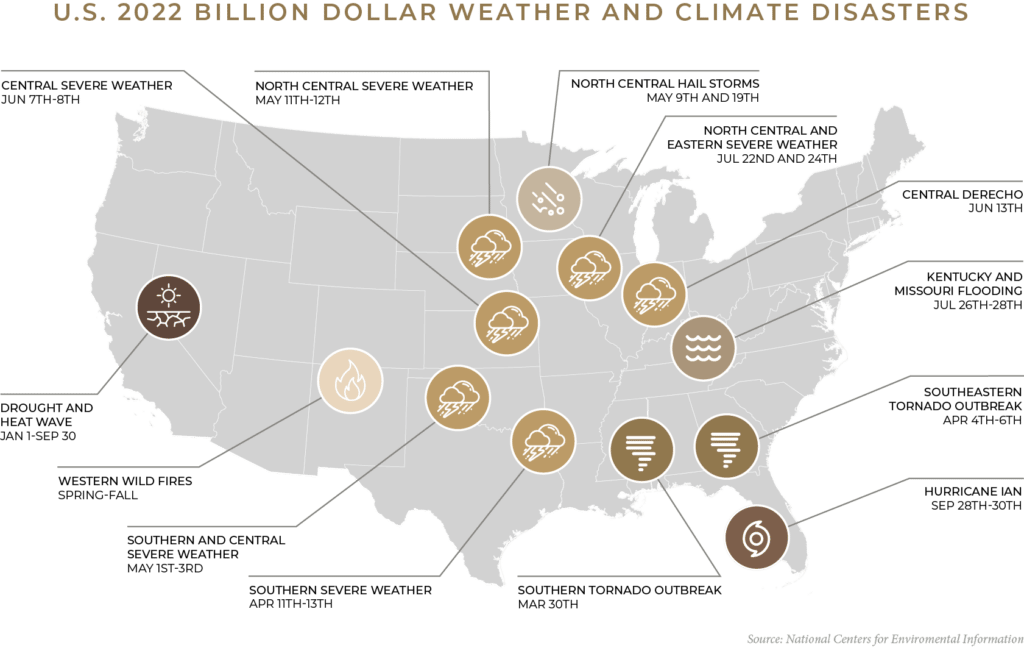2023 Farm Outlook: Top Risk Management Opportunities for Farmers
The future outlook for farmers highlights the importance of risk management and working capital.
It doesn’t take an expert to realize that we are in challenging economic times. The good news is high commodity prices and strong global demand have helped offset higher input costs in 2022 for the American Farmer. The not-so-good news is that uncertainty continues to permeate the farm outlook in 2023 due to geopolitics, weather, and more.
As a trusted financial lender for farmers, ranchers, and landowners across the nation, AgAmerica has continued to monitor the economic landscape of U.S. agriculture and identified six pivotal challenges farmers should consider in their farm risk management plans for 2023:
Agricultural Risks in the 2023 Farm Outlook
To understand how these factors will impact the 2023 farm outlook, we must first understand the underlying cause of each.
1. Weather
The cost of natural disaster events declined considerably in 2022 compared to both years prior, but they are still estimated to have caused nearly $30 million in damage.

Droughts and wildfires have impacted soil moisture and yields for many parts in the western U.S. and will likely remain an ongoing challenge for farmers in these regions. Extremes on the other side in terms of flooding and severe storms affected production in the Southeast, Midwest, and Southern Plains in 2022.
Bottom line: While these events are impossible to predict, the importance of having a farm disaster management plan in place will only increase as weather continues to follow the path of less consistency and greater volatility with each passing year.
2. Energy Markets
Inventories for diesel fuel have been at near-record lows. The war in Ukraine combined with a railroad worker strike threat, and low water levels for the Mississippi River (a key transportation route) continue to strain global supply. These factors have led to a spike in diesel fuel costs—an essential input for American farmers and ranchers. Diesel fuel costs were up an estimated 33 percent in November 2022 over the previous year, with the east and west coasts feeling the greatest market pressure relative to the rest of the country. The Organization of the Petroleum Exporting Countries (OPEC) added to the supply side issues in October 2022 by announcing a production reduction of two million barrels per day.
Bottom line: Fuel costs are expected to remain elevated in 2023. Potential legislative solutions to address these costs are being discussed, but being proactive in reducing fuel needs now will pay off in the future. Strategies such as no-till farming, keeping radiator screens clean, and proper engine maintenance on farm equipment can help reduce fuel needs.
3. Geopolitics
Energy costs aren’t the only thing being affected by Russia’s invasion of Ukraine. Global projections for the 2023 wheat crop are down more than 50 percent, with Ukraine’s 2023 corn crop down as much as 75 percent. Constricted supply will likely lead to strong grain prices through 2023. It will be important for livestock producers to keep this in mind when planning feed purchases. China’s slow growth stemming from its strict COVID policy has affected demand for U.S. agricultural exports, dropping U.S. ag export projections to China to $34 billion in 2023.
Bottom line: The geopolitical landscape is outside the farmer’s control. However, staying informed on how these shifts affect U.S. ag trade is helpful in deciding whether to pivot planting decisions based on the current market.
4. Input Costs
Input costs were consistently the top concern for farmers in 2022, according to monthly farmer sentiment reports from Purdue University. The USDA estimated a nearly 19 percent increase in total input costs for farmers from 2021 to 2022, with fertilizer and fuel costs leading the way.
Bottom line: As interest rates are expected to rise further in 2023, we anticipate input costs to remain elevated for the time being. Review your farm business plan sooner rather than later to determine whether you need to secure additional capital to scale or meet operating needs.
5. Interest Rates
Speaking of interest rates, that was also a big topic of discussion in the ag finance sector as the Fed began to aggressively reign in rising inflationary expectations in March. Interest rates rose significantly (41.4 percent) in 2022, leading to delayed investment decisions. According to the latest USDA farm income outlook, interest expense as a percent of total production expenses rose 18.6 percent to almost seven percent of total expenses.
Bottom line: It is reasonable to expect the federal funds rate to be as high as six percent in 2023, up 1.5 percentage points from the level at the end of 2022. Farmers can leverage short-term, interest-only financing options to offset rising costs.
6. The Strengthening U.S. Dollar
One other impact of the Federal Reserve Board raising interest rates at a rate not seen since the 1980s is the strengthening of the U.S. dollar (USD). If you understand ag trade-weighted foreign exchange rates, you know that a stronger USD means less competitive advantage for U.S. ag exports.
Bottom line: The U.S. dollar index rallied to over 112 at the end of 2022. If rates continue to rise and the USD moves to 118 or higher, it will take a big toll on U.S. meat and grain exports and drop the already-reduced export projections even lower.
Farm Risk Management Opportunities in 2023
As we continue to understand the challenges that 2023 brings with it, we can begin to identify the opportunities within these challenges that can support American agriculture’s resilient future.
- The 2023 Farm Bill: The development of the next Farm Bill will be a focal point in 2023 and presents funding opportunities to help combat higher costs and natural disasters with crop insurance coverage and investments in farmer innovation projects.
- Farmland Values: Higher commodity prices and rising farmland prices were the key growth factors in 2022. Landowners hold a valuable hedge against risk in the form of land equity. Leveraging land equity to conserve capital in an economic downturn can equip you with the capital you need to scale and minimize risk.
- Commodity Prices: When compared to 2021, total cash receipts in 2022 are projected to be up 15.6 percent after adjustment for inflation. Strong prices are expected to carry into 2023 and will help offset higher costs.
- Agricultural Trade: Despite an anticipated $9 billion trade deficit, U.S. ag exports are on track to be the second highest in history, after only the record-breaking high of $196.4 billion seen in 2022. While declining demand from China, our top U.S. ag importer, carries future risk, it also motivates initiatives to diversify our agricultural trade partnerships.
- Technological Innovation and Preparation: A growing interest in ag research and innovation has led to more valuable online resources and broadband connectivity initiatives for rural America. Whether you want to measure expected risk of futures contracts using the CME Group Volatility Index (CVOL™) or assess the financial health of your operation using AgAmerica’s free financial health calculator, the tools and technology available will only increase in the coming year.
- Collaboration: With increased broadband connectivity comes a greater ability to connect and share knowledge with farmers across the nation facing similar challenges. Collaborative farming enables farmers to pool together resources for each operation’s mutual benefit. Opportunities for collaboration also exist with local universities and researchers to see how you can increase efficiency and profitability of your farm.
Fight Risk and Seize Opportunity with AgAmerica
Long story short, chaos and risk will always create challenges – but it also presents opportunities for those willing to adopt a growth mindset. When the outcome looks unclear, the best thing to do is:
- Have a marketing plan ready for multiple outcomes.
- Know your cost of production for 2023.
- Watch your local basis levels.
- Find a lender you can lean on to help you build a long-term strategy.
With a singular focus on ag finance and a commitment to support the future of American agriculture, AgAmerica is that lender. Our unique financing options allow you the freedom to pivot as needed when circumstances change so you’re prepared no matter what.
If you’re experiencing a downtrend in liquidity right now, learn how you can conserve capital with the AgAmerica Pivot™ program.






